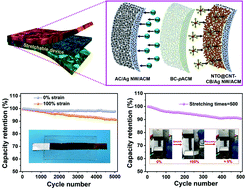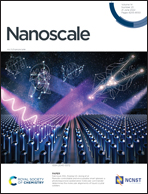Stretchable sodium-ion capacitors based on coaxial CNT supported Na2Ti3O7 with high capacitance contribution†
Abstract
Stretchable sodium-ion capacitors (SSICs) are promising energy storage devices for wearable electronic devices, and the development bottleneck is the realization of stretchable battery-type electrodes with desirable electrochemical properties during dynamic deformation. Herein, we find that electrostatic modification of acidified carbon nanotubes with polyamines can introduce active sites and modulate the surface pH microenvironment, thereby developing a route to realize the in situ coaxial nanometerization of sodium titanate (nCNT@NTO). The nCNT@NTO anode material has a fast Na+ transport and the high capacitive contribution, which can deliver a high specific capacity (206.5 mA h g−1 at 0.1 A g−1) and high rate performance (maintain 51% capacity at 10 A g−1), and the ideal cycle stability (∼93% capacity retention after 1000 cycles at 5 A g−1). In addition, acrylate-rubber with high stickiness and stretchability are served as the elastic matrix both of the stretchable electrodes and quasi-solid-state electrolytes, which endows strong adhesion between electrodes and electrolytes. Thus, the accordingly assembled SSIC delivers high energy density of 8.8 mW h cm−3 (at a power density of 0.024 W cm−3), and excellent deformation stability (89% capacitance retention after 500 stretching cycles under 100% strain).



 Please wait while we load your content...
Please wait while we load your content...